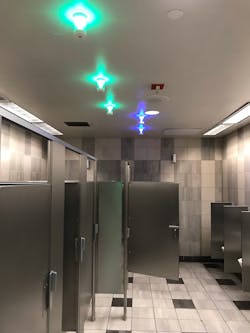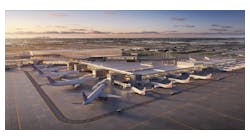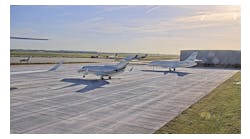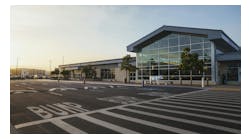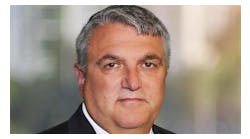When officials at Minneapolis-St. Paul International Airport (MSP) started looking at improvements to the bathrooms in Terminal 1 about 10 years ago, they found some facilities in need of some desperate need of replacement.
Scott Skramstad, assistant director, MSP operations/facilities, said the bathrooms were 30 to 40 years old and in need of updates to meet the needs of modern travelers. Leaders decided it was time to implement a phased modernization program to redesign the restroom of the future to provide the best airport experience.
“The overall intent of the restroom modernization program was to look at upgraded finishes, new technologies, lighting air quality, energy savings upgrades and ADA compliance,” he said. “And really design the next-generation restroom that was going to create passenger satisfaction and really give a high level of service to our customers.”
Improvements were very well received by the public and MSP was named in 2016 as having the best bathroom in the Cintas’ America’s Best Bathroom contest.
A clean win to your bottom line
Bradley Corp. released its annual hand washing survey in February, where it revealed half of the public will either “definitely” or “probably” spend more money in a business with a clean and well-maintained restroom.
Jon Dommisse, director of global strategy and corporate development for Bradley Corp., said despite this finding, about 70 percent of survey participants reported an unpleasant restroom experience, which is an 11 percent increase in just three years.
Dommisse said the survey showed 47 percent of people who go into a restroom and find it in unkempt condition said it was evidence the establishment didn’t care about customers or is run by poor management.
“You have close to 50 percent of the people directly attributing an unkempt or unpleasant bathroom to the quality of the product or service offering that organization has,” he said. “We’ve dug into that more and 45 percent of consumers say they will definitely or probably spend more money at a business that has a clean, well-maintained restroom.”
Dommisse recommends airports make touch-free devices the standard for their facilities, relying more heavily on dryers as opposed to paper towel dispensers and consider 3-in-1 style faucets,.
“One of the biggest blowbacks you have in a bathroom is the reams of paper that are in sinks, on the floor and overflowing waste receptacles full of paper,” he said. “Because of the constant flow of people, you can’t get maintenance people in there enough.”
Dommisse recommends easy to clean surfaces as opposed to just how good it looks.
“If people see a bunch of stains and actual marks on the fixtures, they think they’re full of germs and it looks unkempt,” he said. “If it looks unkempt, I’m probably going to try to go somewhere else or on social media.”
Put technology first
Jimy Baynum, vice president of e-commerce and professional hygiene for Essity, said proactive technology can keep cleaning staff on top of unexpected surges in bathroom traffic.
“I know in most airport operation groups have a huge weather map, they understand weather patterns, they’re rebooking flights well in advance of weather events,” he said. “I don’t think the cleaning crew has a weather map saying ‘oh, I think there’s weather coming, I better staff up today,’ but it’s certainly effecting what they do every day.”
Tracy Davis, vice president of Infax, said the Trax smart restroom system is a business intelligence platform to monitor the movement of people and assets in order to improve operational efficiency while improving the overall passenger experience.
“We all know that restrooms are one of the top three complaints throughout the traveler’s journey and airports really recognize that,” she said. “They want to do all that they can to show a passenger that look, we hear you, we’re helping improve it, we’re giving you a voice to help improve it so the overall operations are efficient and the experience it top-notch.”
The Houston Airport System (HAS) undertook a pilot smart restroom project in 2017. Davis said staff used data to find traffic trends so they could reallocate staff to the location during busier times.
They looked into the issues and discovered the automatic flush sensors were not working properly. They also discovered an issue with paper quality, which would shed onto the floor making the restroom looked uncleaned.
Davis said airports looking at smart restrooms should consider network infrastructure, if they want to use its existing IT network or do they want to use a provided network. They also need to consider pulling power to the location and what steps need to be taken.
“If they can get through that initial hurdle, then the system is really easy to install,” she said.
Smart restrooms have a strong return on investment for all sized facilities.
“The return comes back in that guest experience,” she said. “It comes back in awards. Houston got named four stars by Skytrax.
“It comes back in really seeing an operational efficiency improvement, which might not be directly in dollars, but you can see a huge improvement in the airport as a whole and it definitely makes the investment worth it.”
Los Angeles International Airport (LAX) also started a pilot earlier this year. Part of LAX’s bathroom upgrades included the addition of bathroom stall indicator lights to allow passengers to identify if one of the units are occupied, much like a parking stall indicator light works in parking garages.
Allen Klevens, founder and CEO of Tooshlights, said indicator lights above stalls people to quickly find out if a stall is being occupied.
“For so many years, nobody has ever conquered this and the only place I’d had seen something like this is on an airplane,” he said. “When you see the big red X you know it means don’t go.”
Davis said the Tooshlights system can provide data to show equipment issues. If there is a lack of turnover in one stall, it could show an immediate need for maintenance.
Klevens said the airport can track trends on how many people walk through the bathroom on a daily basis and custodial staff are tracked.
“Now we can compare how long was he or she cleaning for, how many customers came in and used the stalls and then on the way out, we have a happy face/sad face tablet that they’re able to say how their bathroom experience was,” he said.
